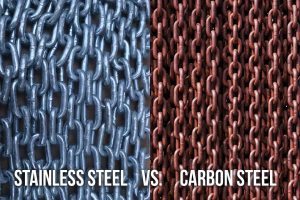 Just because two items are made of steel doesn’t necessarily mean they feature the same type of steel. There are many different types of steel, the two most common being stainless steel and carbon steel. While both types may look the same, there are some key nuances distinguishing one from the other.
Just because two items are made of steel doesn’t necessarily mean they feature the same type of steel. There are many different types of steel, the two most common being stainless steel and carbon steel. While both types may look the same, there are some key nuances distinguishing one from the other.
Stainless Steel
Also known as inox steel (meaning inoxidizable from the French word inoxydable) stainless steel lives up to its namesake by featuring a high resistance to staining caused by corrosion. Normally, when iron-based metals like steel are exposed to oxygen, they undergo a chemical transformation, known as oxidation, that changes their properties. The iron oxidizes while subsequently turning the otherwise hard iron into a reddish-brown metal (iron oxide). Eventually, the iron oxide will oxidize to the point where it disintegrates completely.
Stainless steel is designed to protect against oxidization. It features a minimum chromium content of 10.5% by mass. This is important because chromium, unlike iron, isn’t susceptible to oxidation. Chromium can be exposed to oxygen without developing rust or corrosion, making it an invaluable element in the creation of stainless steel. Stainless steel features a protective layer of chromium that creates a barrier between environmental oxygen and the metal’s iron content which protects it from corrosion.
Carbon Steel
Carbon steel, on the other hand, is characterized by a high carbon content, usually up to 2.1% of its weight. The American Iron and Steel Institute (ASISI) further defines carbon steel by meeting the following criteria:
- No minimum content requirement for chromium, cobalt, nickel, titanium, tungsten, vanadium or other corrosion-resistant metals.
- Minimum required copper content must not exceed 0.40%.
- Maximum content of manganese must not exceed 1.65%.
- Maximum content of copper must not exceed 0.6%
- Maximum content of silicon must not exceed 0.6%
So, what benefits does carbon steel offer? The use of a high carbon content changes the characteristics of steel. More specifically, it becomes stronger and harder. This is why many swords, knives, and other bladed weapons are produced with high-carbon steel. In feudal Japan, swordsmiths pioneered a special type of high-carbon steel, tamahagane, for use in weapons like the katana.
Does carbon steel rust? Yes, carbon steel does rust because it lacks the corrosion-resistant properties of its stainless steel counterpart. Although it’s stronger and more durable than stainless steel, carbon steel may rust and corrode when exposed to moisture. Even small amounts of moisture, including moisture vapor in the air, can cause carbon steel to rust. Furthermore, carbon steel is less ductile than stainless steel.
In Short What Is The Difference Between Stainless Steel and Carbon Steel?
- Stainless steel has a high chromium content which acts as a protective layer against corrosion and rust.
- Carbon steel is high in carbon that when exposed to moisture can corrode and rust quickly.
- Stainless steel is is more appealing to the eye and can be use for decorative products.
- Carbon Steel is stronger and more durable then stainless steel.
Updated September 9, 2020
